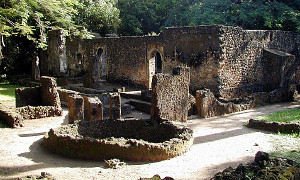 |
Wednesday August 11th,Day 15 - Gede Ruins
|
| Our selected trip for Wednesday
was an afternoon trip organised by the hotel to the ruins of an Islamic
town, Gede, lost in the trees for several hundred years, and a nearby
butterfly farm. This allowed us to spend the morning relaxing by the
pool with the occasional stroll onto the beach. |
|
| The major feature of the beach at this time of
year was seaweed. The prevailing winds bring weed ashore in vast
quantities, in places several feet deep on the beach.
To get down to the waterline there are one or two channels which are relatively free of weed, but it is necessary to walk on it and through it. |
|
| Low tide revealed rocks and rock pools, some sand and some live growing weeds. | |
| Looking back up the beach from the waterline, the pool and beach restaurant is almost hidden in the trees. Just to the North of the hotel are the curio stalls, perched on a narrow strip of beach above the normal high water mark. | |
| The beach seems to be alive with crabs. Small ones living in holes in the sand, below the high water mark, and larger red-eyed creatures like these living in the rock pools and hiding under the rocks. | |
|
After lunch we boarded the hotel minivan for the short trip to Gede,
about 4 miles inland from Watamu and on the main coastal road running
North from Mombasa.
First stop was the Kipepeo butterfly farm, where locally caught butterflies are bred in relatively small numbers for shipping overseas, bringing in valuable foreign currency. It was actually quite difficult to photograph the butterflies. The two enormous stick insects which the guide had perched on his chest were much more co-operative. |
|
|
Gede Ruins Next we walked on to the ruins of an old Islamic City. Very little seems to be known of the history of the city, which was obviously abandoned several centuries ago and completely overgrown by the forest. The purpose of the different buildings is pretty clear from the archeological finds and comparison with other sites. Several tower like structures are apparently tombs. There were a number of mosques with "pulpits". One of the more impressive elements was the routing of water through various channels to fill indoor baths and even flush through "long drop" toilets. |
|
| The age of the ruins was very clear from the size of the trees, particularly the Beobabs, that were growing up through the walls of the ruins. | |
| Enormous millipedes, about 6" long, were widely spread around the ruins. | |
| Back at the hotel, we were able to have dinner in the small waiter service restaurant for the first time. Reservations were taken on a first-come, first-served basis every day at 11am. This was the first day when we were actually in the hotel at that time. | |
Last updated: February 26, 2000 03:48 -0000